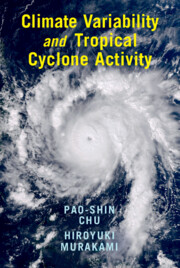Book contents
- Climate Variability and Tropical Cyclone Activity
- Climate Variability and Tropical Cyclone Activity
- Copyright page
- Contents
- Preface
- Abbreviations
- 1 Introduction
- 2 Climate Variability. Part I: Intraseasonal Oscillation
- 3 Climate Variability. Part II: Interannual to Interdecadal Variability
- 4 Climate Variability and Tropical Cyclones
- 5 Subseasonal to Seasonal Tropical Cyclone Prediction
- 6 Extreme Typhoon Rainfall Under Changing Climate
- 7 Future Tropical Cyclone Projections and Uncertainty Estimates
- Index
- References
4 - Climate Variability and Tropical Cyclones
Published online by Cambridge University Press: 17 February 2022
- Climate Variability and Tropical Cyclone Activity
- Climate Variability and Tropical Cyclone Activity
- Copyright page
- Contents
- Preface
- Abbreviations
- 1 Introduction
- 2 Climate Variability. Part I: Intraseasonal Oscillation
- 3 Climate Variability. Part II: Interannual to Interdecadal Variability
- 4 Climate Variability and Tropical Cyclones
- 5 Subseasonal to Seasonal Tropical Cyclone Prediction
- 6 Extreme Typhoon Rainfall Under Changing Climate
- 7 Future Tropical Cyclone Projections and Uncertainty Estimates
- Index
- References
Summary
In this chapter, we focus on climate variability and tropical cyclone (TC) activity for five ocean basins, namely, the western North Pacific, eastern North Pacific, central North Pacific, South Pacific, and North Atlantic. For each basin, the discussion includes the background climatology, the modulation of TC activity by intraseasonal oscillations, the influence of ENSO and the PMM (or AMM) on interannual TC variations, and decadal TC variations. In addition, large-scale low-level flow patterns instrumental for TC geneses and equatorial waves that are regarded as TC precursors are described in Section 4.2.2. Observed changes in TC attributes such as frequency, intensity, translation speed, and poleward migration of the latitude of lifetime maximum intensity are also described at the end of this chapter.
- Type
- Chapter
- Information
- Climate Variability and Tropical Cyclone Activity , pp. 99 - 200Publisher: Cambridge University PressPrint publication year: 2022



